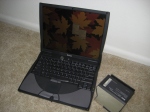Day by day things get a little more busy, and the month of March will be a real grind for me. And so as small tragedies unfold and develop, I have to make quick mental notes and hope to tack them here as time allows.
For example, a week or two ago, this machine suffered the same fate as this one, with the simple act of opening the lid resulting in a thousand tiny shards of plastic bursting in a thousand directions.
And to add insult to injury, the torque of the splintering bent the LCD, and a fine prismatic web enveloped the lower right quadrant. So not only was the casing and chassis on the verge of complete collapse, but the display was suddenly valueless too. Fate — or the gods or whatever deity you prefer — had made its decision, and I was left with the pieces.
I blame the natural deterioration of plastic, which must, I suppose, slowly decay with age and give way to the laws of physics. It doesn’t dry my tears, but that is the way of all flesh, I suppose.
Ironically, not a day later, I’m handed a 700Mhz Thinkpad T22 with most of its components in working condition. A little elbow grease, a few memory chips, and the EzBook is mostly forgotten. Or at least transplanted into a new host. 🙄
And call me crazy, but just about any Thinkpad from pre-2012 or so is now a definite keeper, and that’s the real point of this little speech today. The golden era of the Thinkpad came to a thundering halt only days ago, with the revelation that Lenovo was preinstalling laptops with the faulty certificate tied to Superfish.
Any crudware so bad that the U.S. Department of Homeland Security tells you to uninstall it is an honest-to-god, plain-Jane screwup of colossal proportions. Not that the U.S. government has any real integrity on the subject of computer security, but you couldn’t sell me a new Lenovo now for holding shut the screen door to my back yard. I don’t think it could handle that much responsibility.
Of course, the slow decline of Lenovo machines was something I had sensed earlier than this week. The newest Thinkpad I have now is a T410 that’s already pushing four or five years old, and it’s only so-so in my mind. The newer Lenovo-branded laptops I’ve seen were even more disappointing.
A friend’s Y560 had so much bounce in the keyboard plate that I thought I was typing on a trampoline. And at a time when it was barely two years old, he’d already lost sound in one speaker, torqued the earphone jack so badly he couldn’t insert a plug to it and had a lot of play in the hinges.
I’ve seen a few Yogas and some high-end “Thinkpads” in the past year too, and nothing enthused. Most were not far off from mid-grade department store machines.
Sad, really, for the line that once held the mighty T61p, which was a solid full-size performer with fantastic graphics at a fantastic price. Or the X60, which is still available in resale and is probably one of the best portable dual-core full-feature laptops ever made. I’ve had one of those and an X61 too, and I’d be willing to part with cash — actual cash — to find another one in decent condition.
And that from a person who gets most of their machines for free or as trade.
I’d even be willing to reach back to the X120e, or the X31 or even the i-Series for positive experiences. In fact, I can think of only one Thinkpad I’ve had in the past decade that didn’t leave me smiling, and that one dated back to the early days of Pentiums, and the rise of the brand. From my perspective, the arc of the Thinkpad started around the Pentium II, tapered off four or five years ago, and came to a crashing halt last week.
Of course that does mean any Thinkpad you’re holding that wasn’t built post-2012 is a winner, at least in my book. I really don’t mind if it’s a Pentium, a II, a III or a 4; what you have is a bona-fide slice of computing history, made at a time when the Thinkpad was trustworthy, dependable, flexible and powerful. I’ve got more than my share right now, and I’ve had an even broader array in the past — and I’d still be inclined to invest in one that had potential.
I have to draw the line when the plastic shatters and tiny black splinters fly across the room, though. 😐 That is the way of all flesh, I suppose.





